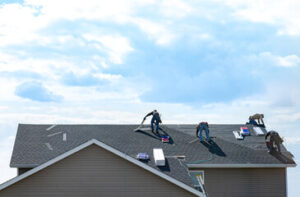Rosenberg Plumbing is an integral part of your home’s structure. Its role is to supply water and remove waste in an efficient manner.

Plumbers interpret blueprints and building codes to plan and execute plumbing installations. They also collaborate with other professionals to ensure that plumbing systems integrate seamlessly into building projects and meet standards and regulations.
Modern plumbing systems are a marvel of engineering, but they didn’t come together overnight. The roots of plumbing go back to ancient civilizations who developed ways to control water for drinking, cooking and washing, as well as waste disposal. The Romans are credited with some of the most significant advancements in plumbing, building towering aqueducts and creating a culture of bathing. They also pioneered latrines and sewer systems to remove disease-causing waste from densely populated urban areas.
The Middle Ages saw a decline in plumbing technology, with people using cisterns for storage and hand-pumping water into their homes from fountains or streams. This didn’t bode well for health, cleanliness or olfactory receptors, and was also bad for city water supplies, which were often polluted by human waste and sewage.
In the 1800s, new plumbing innovations began to emerge, including toilets with flushing mechanisms and showers with adjustable temperature settings. A sewer system was built in Chicago in 1856, after a deadly outbreak of water-borne diseases caused by the city’s uncontrolled sewage.
The ability to mass produce pipes made it feasible to put plumbing in more homes, and innovations such as the Manning formula for calculating sloped drains allowed for the efficient use of water. The plumbing industry was further revolutionized by the invention of cast iron, which allowed for the production of more durable and longer-lasting fixtures.
Today, plumbers are still called upon to fix broken pipes and other problems that occur in our homes. In fact, this is one of the fastest-growing professions, with demand expected to rise 13% by 2022. And it’s not just because we need clean water to drink and wash with; plumbers play a critical role in maintaining our safety and security, too.
So, the next time you see a plumber working in your home or business, remember that they’re a vital member of our society who deserves respect and gratitude for keeping us safe and sound. And don’t forget to tip them! They work hard to earn it.
Materials
Pipes are a vital part of your home’s plumbing system, delivering a consistent supply of water and creating a strong drain, waste, and vent (DWV) network. The material of these pipes plays an important role in the overall function and strength of your plumbing, but each type of material has its own advantages and disadvantages. Understanding the different pipes and materials used in your plumbing can help you make informed choices that best suit your needs.
One of the most common pipe materials is copper. This material is preferred for its durability and resistance to corrosion. It’s also able to withstand high water pressure and temperature fluctuations. However, it’s not suitable for hot water lines and is more expensive than some other piping materials.
Another common piping material is galvanized iron, which is strong and easy to work with. However, it can rust over time and cause leaks in your plumbing system. Another less popular option is silicone, which is highly flexible and durable. It’s also resistant to acidity and alkalinity, making it ideal for underground plumbing.
Plastic piping has grown in popularity in recent years due to its versatility and affordability. Pipes made of polyvinyl chloride (PVC) and polypropylene are tolerant to a variety of chemicals, making them ideal for plumbing in homes with wells or chemically-treated water. However, PVC is not suited for use with hot water lines and should not be exposed to extreme temperatures.
Acrylonitrile butadiene styrene, or ABS, is an impact-resistant, durable material that’s often used in drain, waste, and vent systems. It’s easily recognizable by its black color and is preferred for its durability and ease of installation. It’s not recommended for hot water lines, but can withstand significant physical stress and is more resilient to damage caused by freezing temperatures.
Stainless steel pipes are long-lasting and durable, but are not as flexible as other piping materials. They are more costly than other piping materials, but are highly resistant to corrosion and can withstand high temperatures. However, they can be difficult for do-it-yourselfers to install, and are not a good choice for underground pipework.
Functions
Plumbing is the system of pipes, fixtures and fittings that delivers fresh water to homes and businesses and safely removes waste and sewage. It is essential to sanitation, hygiene and overall health. Proper maintenance and regular repairs are key to a functioning plumbing system. A malfunctioning plumbing system can lead to a number of issues, including water damage, mold growth and safety hazards.
The plumbing industry is highly competitive and requires extensive training and certification. Plumbers must keep abreast of new technologies, equipment and regulations. They must also be prepared to handle emergency situations. In addition, they must be able to work with tight deadlines and limited resources.
Despite the many challenges faced by the industry, plumbing services remain a promising sector. The global demand for water is growing, and the industry is undergoing significant consolidation. The market is expected to reach $1.5 trillion by 2035. This makes it a lucrative investment opportunity for investors.
Plumbing involves the installation, repair and maintenance of pipes and fixtures that carry water and sewage throughout a building. It also includes the appliances that use this water, such as sinks, toilets, and showers. The plumbing industry is regulated by local and state authorities.
In addition to installing and maintaining plumbing systems, plumbers must be able to diagnose problems and make repairs. They must also be able to manage employees and work with customers. In addition, they must be able handle the stress of working with dangerous machinery and tools.
A successful plumbing company needs to invest in specialized tools and equipment, such as drain snakes and pipe cutters. These are considered fixed assets because they have a useful life of more than one year and are necessary for the operation of the business. In addition, a plumbing business needs to invest in office equipment such as computers, printers and phones for administrative tasks.
A successful plumbing company must have a strong online presence. This can be accomplished by creating a Google Business Profile, which allows potential customers to find your company and read customer reviews. It also provides your contact information, enabling customers to easily schedule appointments with you. In addition, a Google Business Profile can help you improve your search engine optimization (SEO) strategy and increase the visibility of your website.
Design
Plumbing is a complex system that delivers fresh water and safely removes wastewater. It is essential to sanitation and overall health, and it must be properly maintained in homes, businesses, and industrial facilities. Plumbing uses pipes, valves, and fixtures to carry water at high pressure from a source to faucets, showers, sinks, dishwashers, toilets, and other appliances. It also includes a drainage system that transports waste to the sewer or septic tank.
The layout of a plumbing system is determined by the building’s structure and water sources. Proper planning ensures that water supply lines are conveniently located near appliances and fixtures, while drain lines are positioned for efficient waste disposal. Plumbing systems must also be designed for future expansions and renovations. This includes ensuring that pipes can accommodate additional fixtures, changes in water usage, and increased demand for hot water.
There are two main types of plumbing: supply and drainage. The supply system brings potable water to appliances and fixtures throughout a building. It consists of pipes, valves, and a water heater. The pipes in this system are typically made from materials like copper, PVC, or PEX. They are designed to withstand high water pressure and resist corrosion and rust. The valves in this system control the flow of water and prevent leaks.
In contrast, the drainage system takes care of the waste from faucets, showers, and other fixtures. The system consists of drain lines, traps, and the sewage system. The drain lines in this system are sloped to prevent sewage back-up and keep wastewater flowing in the proper direction. The traps in this system protect against the buildup of debris and odors. The sewage system transports wastewater to the public sewer line or septic tank.
A plumbing system must also include a venting system to maintain air pressure and prevent siphoning. The vent pipes connect upward from the drain and soil stacks to the roof and exterior of the building. This system also helps to remove foul odors and prevents pressure changes in the vent stacks. While the functions of a plumbing system are relatively straightforward, problems can occur. Understanding common plumbing issues can help you address them quickly and effectively. Some of the most common plumbing problems include:


